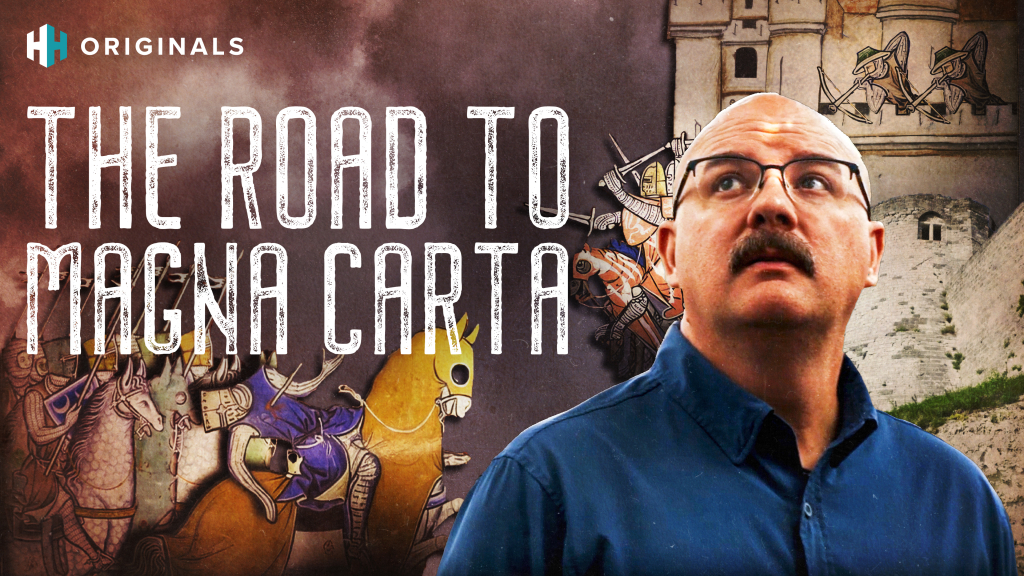Magna Carta – one of the most important documents from the medieval period. It’s still held up as a totem of democracy even in today’s turbulent world. But why did Magna Carta get written and sealed in the first place?
In History Hit’s new documentary, The Road to Magna Carta, Dan Snow and Professor Michael Livingstone explore the seismic shifts in medieval power that culminated in one of history’s most pivotal moments.
In this gripping first episode, Professor Michael Livingston heads to France to explore the continental side of the Magna Carta story. His exploration begins in 1214, a year before Magna Carta’s sealing, with the pivotal Battle of Bouvines. This wasn’t merely a clash of armies; it was the decisive moment that shattered English power in Europe and, crucially, brought King John to his knees at home.
What led to the Battle of Bouvines, and why was it so crucial to Magna Carta’s origin?
 Watch Now
Watch NowKing John: A reign on the brink
King John ascended the throne in 1199, inheriting the vast Angevin Empire – a sprawling dominion across England, parts of Ireland and Wales, and over half of France. This formidable inheritance, built by his father Henry II and fortified by a strategic marriage to Eleanor of Aquitaine, made England’s king one of Europe’s most powerful figures. Land was wealth, and the empire’s extensive territories fuelled royal coffers and enriched England’s barons, who held lucrative interests across France.
However, this power stirred bitter resentment, particularly from the shrewd and ambitious King Philippe II of France. As medieval historian Dan Jones explains, Philippe was systematically transforming the French monarchy into a dominant force. Alarmed by the English king’s growing influence, Philippe resolved to dismantle the Angevin Empire.
The loss of Normandy
Henry II’s death in 1189 seemed a golden opportunity for Philippe, but Henry’s heir, Richard the Lionheart, was a formidable military leader. Philippe waited. His chance came in 1199 when Richard was killed while on military campaign, paving the way for his less astute brother, John, to become king. Though John initially secured peace through the Treaty of Le Goulet, he effectively conceded that most of his French lands were merely held from the French Crown, ceding vital strategic control.
Normandy, with the River Seine linking Paris to the sea, was crucial to Philippe’s ambitions. He soon accused John of violating their agreements, setting his sights on the gateway to Normandy: the formidable Chateau Gaillard. Built by Richard the Lionheart, this cutting-edge fortress, perched 90 metres above the Seine, was a symbol of English power.
But John gravely underestimated Philippe’s resolve. After a gruelling nine-month siege, John’s desperate attempt to relieve the castle failed. In March 1204, Chateau Gaillard fell. Dr Caroline Burt emphasises, this was a “total disaster” for John’s reputation, eroding confidence and signalling the irretrievable loss of Normandy. By 1205, the once-mighty Angevin Empire was a mere shadow of its former self.

Chateau Gaillard
Image Credit: History Hit
The cost of ambition: John’s war chest
John vowed to reclaim his lost lands. His decade-long obsession with regaining his continental possessions fundamentally reshaped his governance of England. As Professor David Carpenter highlights, John spent ten years meticulously raising a “great war chest,” tripling his revenues to finance a new campaign and secure crucial allies.
“If you want to know why there’s Magna Carta,” Carpenter states, “it’s because the tax bill has tripled in 10 years.”
This unprecedented financial burden, combined with the barons’ own losses of French lands, pushed England’s nobility to breaking point. Their frustration mounted with a king who had lost them prestige and income, and who seemed incapable of reversing his fortunes. John knew diplomacy wouldn’t suffice; he needed a decisive military victory.
The fateful alliance and the Battle of Bouvines
By 1214, John had meticulously assembled a grand alliance of European powers hostile to Philippe, including the Holy Roman Emperor Otto IV. This was John’s last, desperate gamble, a monumental investment that strained his relations with his barons to their absolute limit. Only victory could save him.
The strategic plan was to encircle Philippe and trap him in Paris. While John’s initial advance into Angers went well, a confrontation with Philippe’s son, Louis, forced John into a disastrous retreat. This left him stranded on the west coast, notably absent from the decisive battle that would define his reign.
That battle unfolded in Bouvines, a small town in north-east France. Philippe’s forces clashed with the coalition army in a brutal, bloody affair. Despite their size and funding, the allied forces were fractured, lacking common language and unified leadership. Philippe exploited these divisions, systematically fending off uncoordinated attacks. Soon, alliance leaders began to surrender. Philippe had secured a resounding victory, solidifying his status as “Philippe Augustus” and establishing France as the dominant power in Europe.

The Battle of Bouvines, by Horace Vernet
Image Credit: Museum of the History of France / Public Domain
The unavoidable road to Magna Carta
For John, defeat at Bouvines, even in absentia, was catastrophic. As Dan Jones powerfully explains, “to lose a battle like Bouvines… is a direct expression of God’s opinion about King John, and God’s opinion is that King John does not deserve to prosper.”
Dr Caroline Burt emphasises that Bouvines was the critical catalyst: “You can’t really envisage Magna Carta happening without something like Bouvines. It opens up the political space for opposition to gain traction.” The barons, bled dry and utterly disillusioned, recognised that John’s unchecked authority, particularly regarding taxation, could not continue. They had to draw “some red lines.”
John had lost everything – his lands, his money, and crucially, the trust of his people. Less than a year later, with nowhere left to turn, King John was forced by his barons to seal the Magna Carta.
The Road to Magna Carta, Episode 1 is available to watch now:
 Watch Now
Watch Now















